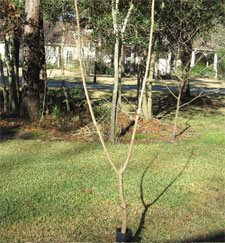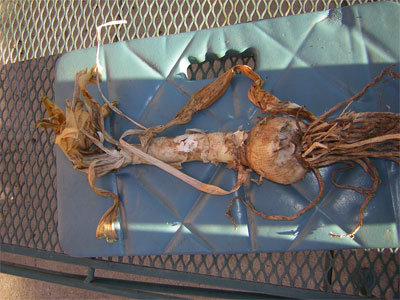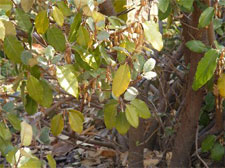Question and Answer – March 2011
Neil encourages you to send your questions along with a pertinent photo to e-gardens. Each issue, he chooses 5-10 questions and photos of the greatest general reader interest to answer here. He respectfully asks that you not send plant ID questions to him here, since they will be of interest primarily only to you. If you don’t have a question that requires a photo, please call his radio programs. Also, Neil has answered the 100 Most Asked Questions on his website. http://neilsperry.com/maq/

Question: Our Chinese pistachio was nipped by a deer shortly after we planted it. It now has this low fork about 30 inches from the ground. Should we prune it to get it to branch out, or leave it alone? L.B., no city given.
Answer: It would be much better for the long term vigor of the tree if you could eliminate that very narrow branch angle. I would suggest removing the left branch virtually flush with the trunk. It appears that the crooks of the right-hand branch are small enough that they will soon be absorbed by the thickening of the trunk. That pruning should be done before it starts growing again this spring.
Question: A friend dug up a whole bunch of his crinum and hardy amaryllis bulbs several weeks ago and gave them to me. I never got around to planting them. They seem to have survived the cold sitting in the garage. Is it too late to put them in the ground? A.B., Highland Village.

Answer: Not at all. In fact, you’re probably lucky that they were protected as cold as things got. Work up a good bed for them, and get them planted as soon as you can now.

Question: I have several elaeagnus on my acre lot. They have all grown and prospered for five years, but several of them began to develop problems last spring. They started yellowing, and then two plants lost all of their dried leaves. Even plants that are 200 feet apart are affected. Is it possible that it’s verticillium wilt? I did find some online references to it. B.R., Prosper/Celina boundary.
Answer: From the photo of the infected branch, it does appear that the plant flowered last fall and set a good crop of fruit over the winter. That should have been a good sign. I have seen elaeagnus die in the way you described, but I’ve normally assumed they just got way too dry. (The plant is normally drought-resistant.) The references I saw online to verticillium wilt with elaeagnus were all for the species E. angustifolia, Russian olive. You have E. pungens, fruitland silverberry. I honestly don’t know if it’s susceptible at all. The Plant Disease Diagnostic Laboratory at Texas A&M could culture it for you for a small fee. The biggest cause of trouble I saw with elaeagnus last year was with lace bugs. They turn leaves mottled yellow, then tan. You’ll see black, waxy specks on the backs of affected leaves if lace bugs are involved. Systemic insecticides work well with them, but I’m not totally convinced they caused your plants’ problems. At this point, my best advice would be to send samples of plants in active stress from the problem to the diagnostic lab. Sending dead tissues won’t give them much to work on. Hope that’s at least of some help.

